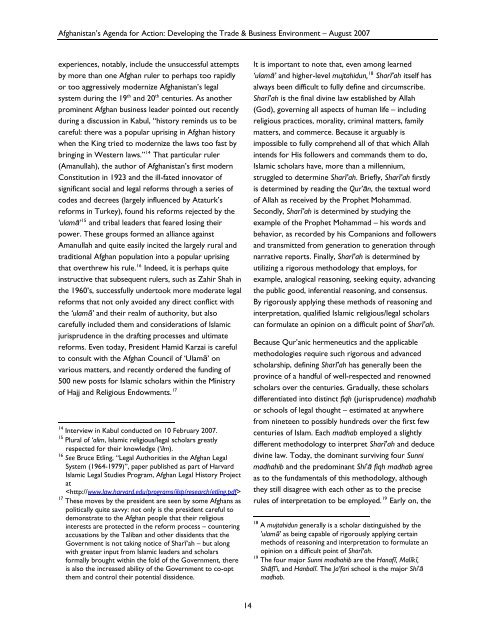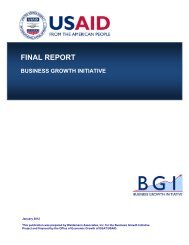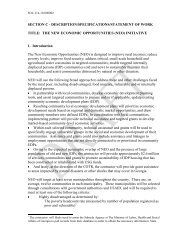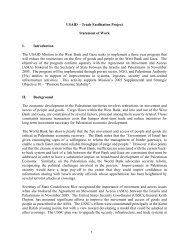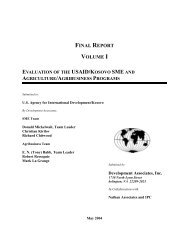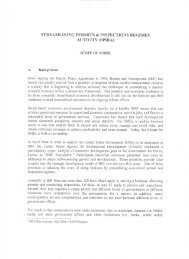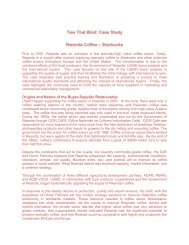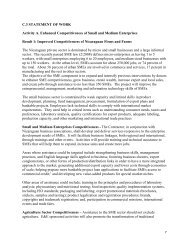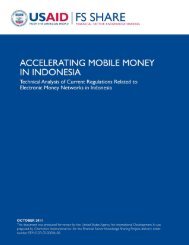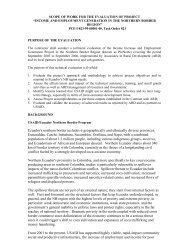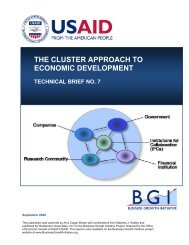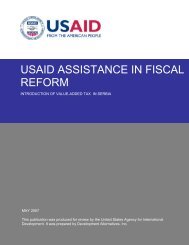Afghanistan's Agenda for Action - Economic Growth - usaid
Afghanistan's Agenda for Action - Economic Growth - usaid
Afghanistan's Agenda for Action - Economic Growth - usaid
Create successful ePaper yourself
Turn your PDF publications into a flip-book with our unique Google optimized e-Paper software.
Afghanistan’s <strong>Agenda</strong> <strong>for</strong> <strong>Action</strong>: Developing the Trade & Business Environment – August 2007experiences, notably, include the unsuccessful attemptsby more than one Afghan ruler to perhaps too rapidlyor too aggressively modernize Afghanistan’s legalsystem during the 19 th and 20 th centuries. As anotherprominent Afghan business leader pointed out recentlyduring a discussion in Kabul, “history reminds us to becareful: there was a popular uprising in Afghan historywhen the King tried to modernize the laws too fast bybringing in Western laws.” 14 That particular ruler(Amanullah), the author of Afghanistan’s first modernConstitution in 1923 and the ill-fated innovator ofsignificant social and legal re<strong>for</strong>ms through a series ofcodes and decrees (largely influenced by Ataturk’sre<strong>for</strong>ms in Turkey), found his re<strong>for</strong>ms rejected by the‘ulamā’ 15 and tribal leaders that feared losing theirpower. These groups <strong>for</strong>med an alliance againstAmanullah and quite easily incited the largely rural andtraditional Afghan population into a popular uprisingthat overthrew his rule. 16 Indeed, it is perhaps quiteinstructive that subsequent rulers, such as Zahir Shah inthe 1960’s, successfully undertook more moderate legalre<strong>for</strong>ms that not only avoided any direct conflict withthe ‘ulamā’ and their realm of authority, but alsocarefully included them and considerations of Islamicjurisprudence in the drafting processes and ultimatere<strong>for</strong>ms. Even today, President Hamid Karzai is carefulto consult with the Afghan Council of ‘Ulamā’ onvarious matters, and recently ordered the funding of500 new posts <strong>for</strong> Islamic scholars within the Ministryof Hajj and Religious Endowments. 1714 Interview in Kabul conducted on 10 February 2007.15 Plural of ‘alim, Islamic religious/legal scholars greatlyrespected <strong>for</strong> their knowledge (‘ilm).16 See Bruce Etling, “Legal Authorities in the Afghan LegalSystem (1964-1979)”, paper published as part of HarvardIslamic Legal Studies Program, Afghan Legal History Projectat17 These moves by the president are seen by some Afghans aspolitically quite savvy: not only is the president careful todemonstrate to the Afghan people that their religiousinterests are protected in the re<strong>for</strong>m process – counteringaccusations by the Taliban and other dissidents that theGovernment is not taking notice of Sharī’ah – but alongwith greater input from Islamic leaders and scholars<strong>for</strong>mally brought within the fold of the Government, thereis also the increased ability of the Government to co-optthem and control their potential dissidence.It is important to note that, even among learned‘ulamā’ and higher-level mujtahidun, 18 Sharī’ah itself hasalways been difficult to fully define and circumscribe.Sharī’ah is the final divine law established by Allah(God), governing all aspects of human life – includingreligious practices, morality, criminal matters, familymatters, and commerce. Because it arguably isimpossible to fully comprehend all of that which Allahintends <strong>for</strong> His followers and commands them to do,Islamic scholars have, more than a millennium,struggled to determine Sharī’ah. Briefly, Sharī’ah firstlyis determined by reading the Qur’ān, the textual wordof Allah as received by the Prophet Mohammad.Secondly, Sharī’ah is determined by studying theexample of the Prophet Mohammad – his words andbehavior, as recorded by his Companions and followersand transmitted from generation to generation throughnarrative reports. Finally, Sharī’ah is determined byutilizing a rigorous methodology that employs, <strong>for</strong>example, analogical reasoning, seeking equity, advancingthe public good, inferential reasoning, and consensus.By rigorously applying these methods of reasoning andinterpretation, qualified Islamic religious/legal scholarscan <strong>for</strong>mulate an opinion on a difficult point of Sharī’ah.Because Qur’anic hermeneutics and the applicablemethodologies require such rigorous and advancedscholarship, defining Sharī’ah has generally been theprovince of a handful of well-respected and renownedscholars over the centuries. Gradually, these scholarsdifferentiated into distinct fiqh (jurisprudence) madhahibor schools of legal thought – estimated at anywherefrom nineteen to possibly hundreds over the first fewcenturies of Islam. Each madhab employed a slightlydifferent methodology to interpret Sharī'ah and deducedivine law. Today, the dominant surviving four Sunnimadhahib and the predominant Shi'ā fiqh madhab agreeas to the fundamentals of this methodology, althoughthey still disagree with each other as to the preciserules of interpretation to be employed. 19 Early on, the18 A mujtahidun generally is a scholar distinguished by the'ulamā' as being capable of rigorously applying certainmethods of reasoning and interpretation to <strong>for</strong>mulate anopinion on a difficult point of Sharī’ah.19 The four major Sunni madhahib are the Hanafī, Malīkī,Shāfī'i, and Hanbalī. The Ja’fari school is the major Shi'āmadhab.14


